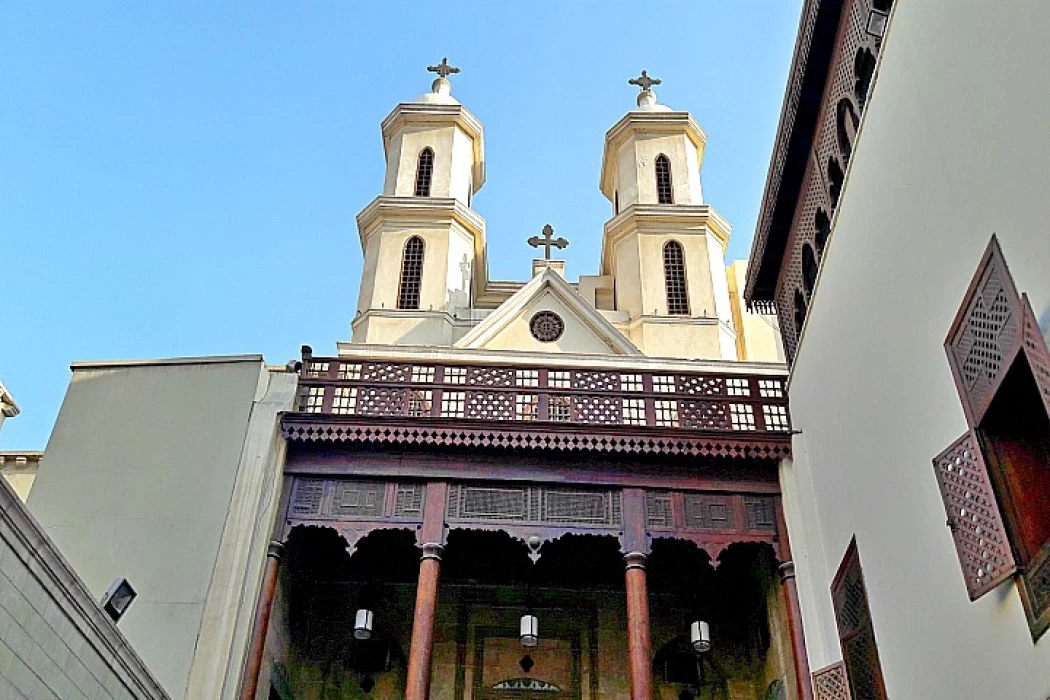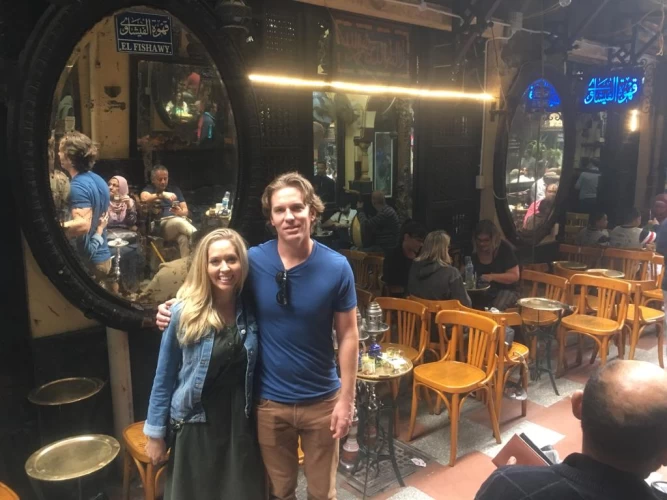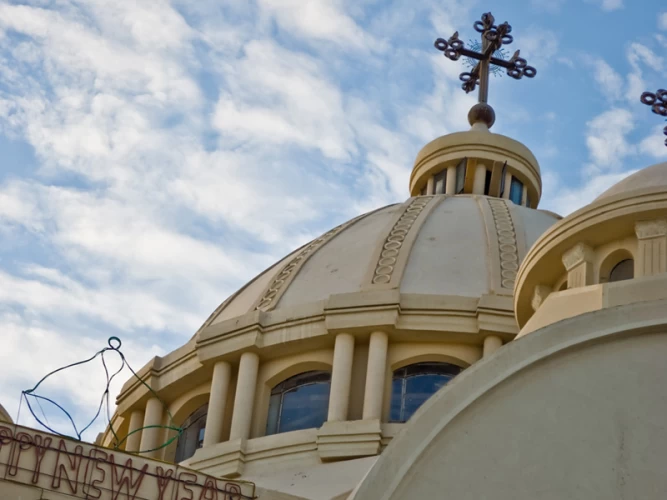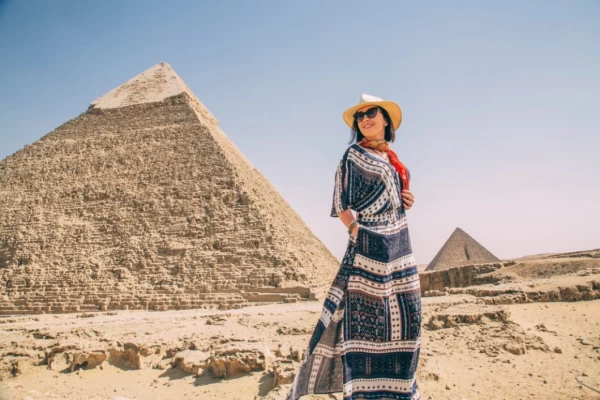
Hanging Church
The Hanging Church derives its name from its placement above the gatehouse of Babylon Fortress, a Roman fortress in Coptic Cairo (Old Cairo); its nave hangs over a tunnel. The church is ascended via twenty-nine steps; early visitors to Cairo dubbed it "the Staircase Church." Because the land surface has risen by around six meters since the Roman period, the Roman tower is mostly buried beneath the earth, decreasing the visual impact of the church's elevated position.
The street entry is through iron gates with a pointed stone arch. The nineteenth-century front with twin bell towers is seen behind a tiny courtyard embellished with modern art biblical patterns. Up the steps and through the entryway is a further tiny courtyard leading to the eleventh-century exterior porch.
The Hanging Church was most likely built during the Patriarchate of Isaac, while an earlier church structure may have existed somewhere as early as the third or fourth century. However, the church was first mentioned in the biography of patriarch Joseph I (831-849), when Egypt's governor paid a visit to the edifice. Pope Abraham (975-978) extensively reconstructed the cathedral, and it has undergone numerous repairs, including an intensive repair and restoration of the church and its surroundings finished in 2011. The Coptic Museum received historical objects that were no longer in use. A series of ten wooden panels from a door at the church, etched with Christian imagery circa 1300 AD, can be found in the British Museum.
The Babylon Fortress was a Roman fortification, although Coptic historians dispute its origins. Some trace its origins back to the nineteenth century B.C., when Pharaoh Sesostris conquered the Babylonians and seized Egypt's prisoners as slaves. The prisoners rebelled and built a fortification around their home, which became known as Babylon. Others think that Nebuchadnezzar, King of Babylon, erected the fortification in the late sixth century B.C. after conquering Egypt. The Hanging Church was built over the citadel's original south bastions, which marked the main gate to the castle and gave the church its 'hanging' appearance. The original atrium entry beneath the church features niched walls that once housed statues. Later additions included superimposed columns and brick arches.
The Hanging Church is one of Cairo's oldest churches, competing only with Saint Sergius and Bacchus Church, also known as Abu Sargah. The church was renovated in the sixth century, removing much of the evidence of its founding. Carved reliefs thought to be from the earlier construction mirror those seen in the early Syrian churches, which date back to the third or fourth century. There is also a carved beam over the entranceway that dates back to 284 AD when the Coptic era began.
During a quarrel with patriarch Anba Yusab in 840 AD, the Armenian governor Ali ibn Yahia largely demolished the church. It was eventually transformed into a mosque until the ninth century when it was rededicated. The Coptic patriarchate, which had previously been based in Alexandria, moved to the Hanging Church in the eleventh century.
Pope Abraham (975-978) commissioned one of the church's first major repairs. The church has also been restored under the reigns of Caliph Haroun El Rasid, El-Aziz Bi'Allah Al Fatemi, and Al-Zaher Al Eazaz Din Allah. The chapel ceiling fell in 1983 when an engineer removed an inner support, causing extensive damage to the artwork inside. The 1992 Cairo earthquake caused more damage to the structure's walls, resulting in an additional restoration in 1998 that was completed in 2011.
The Hanging Church is Cairo's most well-known Coptic Christian church, and it may have been the first to be erected in the basilica style. The church has been the site of several claimed Marian apparitions. She is claimed to have come in a dream to Pope Abraham in the 970s, telling him how Simon Tanner's faith moved the Mokattam Mountain.
The Hanging Church is devoted to the Virgin Mary and includes sanctuaries for her, Saints John the Baptist, and George.
The church hosted numerous important occasions for the Coptic authority in Cairo. These include the selection and burial of patriarchs, the former from the 11th to 14th centuries and the latter only between the 11th and 12th, as well as the consecration of holy oil and the adjudication of heresy trials; the selection of the date of Easter for each year was another important procedure held within.[6] These activities take place at the Hanging Church as a result of the patriarchal seat being moved from Alexandria to Cairo in the 11th century.
The Coptic Orthodox Pope of Alexandria has traditionally held his seat at Alexandria. However, as governmental forces shifted from Alexandria to Cairo during the Muslim conquest of Egypt under Pope Christodolos' reign, the Coptic Pope's permanent and official residence at the Hanging Church in 1047.
The Hanging Church houses 110 icons, the oldest of which dates back to the 8th century, although the majority of which are from the 18th century. In 1898, Nakhla Al-Baraty Bey, the church's superintendent, offered some of them as presents.
The church's current structure consists of a primitive church in the south and a major church in the north, which are thought to have been erected between the third and seventh centuries, respectively. The main church is a basilica-style structure with three apses enclosed by a rectangular outer wall. The nave is encircled by three aisles.[Citation needed] Its design is double-aisled but lacks transepts. The ambon (pulpit) has 15 Islamic columns set on a white marble slab. By the late nineteenth century, the original church had three chapels and a baptistery, with the first chapel connecting to the primary church's south nave.[10] The church was periodically remodeled and restored in reaction to pillage. This renovation includes the erection of a barrier wall during the reign of caliph al-Hakim.
Neglect resulted in the destruction or ruin of certain original church components. Modern replacements date from the nineteenth century.
Altars
By the nineteenth century, none of the Coptic churches' three old altars remained, and they were replaced by marble slabs.
Ciboria
The original ciboria were said to have been present at the altars, but they were later replaced.
Mosaics and Relief
An ambo north of the primary church's central nave contains mosaics in the shape of relief crosses. The primitive church has mosaics in a depression on the south wall.
Discover the Hanging Church of the Virgin Mary
Al-Muallaqa, or the Hanging Church of the Virgin Mary, is well-known in Egypt for its worldwide recognition of its historic and religious significance. Based in the Old Coptic Cairo region, the historically symbolic religious building stands amid the Old Cairo religious district. Here, tourists from all corners of the world come to visit, enchanted by its architecture and historical significance. In the company of Adam, Salah, and Miron the Copt Museums, The Church of the Hanging, the Ben Ezra Synagogue, Abu Serga Church, and the Coptic Museum, bring the ancient and cultural background of Egypt closer to people than any other site.
Among all the related Egypt tour's regular points, visiting the Hanging Communion of St. Mary's Church is a must. Dubbed the "Hanging Church," it was so called because it was built on top of the former two Roman fortress towers; the place associated with the Coptic faith also had a historical significance with it being the first place of the Coptic patriarchal seat. It transitioned from Alexandria, which at that time was rendered uninhabitable, to Al Fustat, where it found a new home. The physical attribute of being a loft is a standing proof of the genius of its developers as well as the strong belief with which they have been keeping it in all these years.
The Roman Fortress of Babylon
The Hanging Church is situated above the relics of the Roman battlements of the Babylon Fortress. The wall was built during the reign of Emperor Trajan, and it was primarily utilized as a defense system around the Red Sea-Nile Canal. Also called the “Castle of Babylon,” this fortress was constructed to defend the eastern gate of Egypt, and even after the Islamic Conquest, it played an important role in Easter fortifications. The term “Babylon’’ is said to have derived from the story of King Senusret of Ancient Egypt, who is believed to have taken some captives from Babylon in a bid to build the stronghold upwards, creating a barrier to ward danger from one of its sides.
The Hanging Church is one of the oldest in Egypt and has been significant in the history of Coptic Cairo. It was built over the remains of a Roman fort with a ceiling that resembles Noah’s Ark. The Holy Family of Jesus, Mary, and Joseph is said to have fled to this part of the city from King Herod. Entering such a place feels like time travel, where one can picture the Holy Family's travels and ponder their thoughts. Add this to the typical visits to places like Luxor, and Aswan, or a sailing trip on the Nile, and you get a memorable experience in Egypt.
The architectural setup of the Hanging Church is indeed very different from any other church. The interior of the church is designed into a wooden structure that is stylized like Noah’s Ark, and the section of the church is divided into four different wings, each of which is enclosed within good-looking marble pillars. Inside there is also a granite tank and a marbled pulpit that is decorated with mosaic works that are all craftsmanship enduring symbols. The walls of the church carry numerous icons from the 15th century, which allow the visitors to appreciate the complexity of Coptic art.
One of the most breathtaking aspects of the church is the wooden lantern screen, which is decorated with many beautiful icons carved crosses, and geometric patterns made of ebony and ivory. The churches contain artwork and architectural styles that depict the traditions of Coptic Cairo that have been used and admired for centuries.
A Journey Through Time and Faith
Visiting the Hanging Church of the Virgin Mary is an invitation to experience the complex history and religious traditions of Egypt. Thus, it is imperative that whenever a Giza Pyramids and Coptic Cairo one-day tour package is available, it should be embraced, for it will enrich one’s experience of the alluring and rare arts in the country. The Hanging Church is guaranteed to enhance your experience of Egypt, as it has both religious teachings and magnificent designs that are appealing ten times more than its spiritual importance alone.
The early hours of the morning or the late hours of the evening: These moments are best to be spent to avoid people and have a better experience. Besides, the lighting settings during these times are more striking and may even enhance the beauty of the church’s interiors. Weekdays Visiting on a weekday can also mean fewer visitors, as more are most likely to come on weekends, especially on Fridays and Sundays.


















